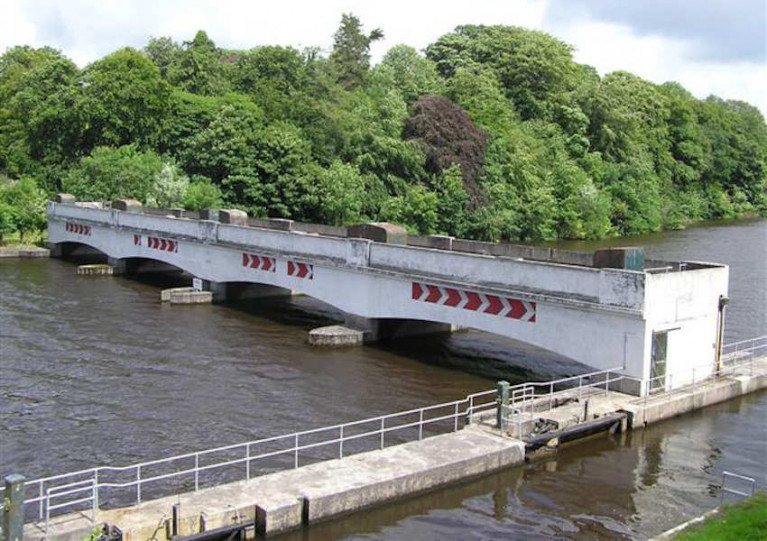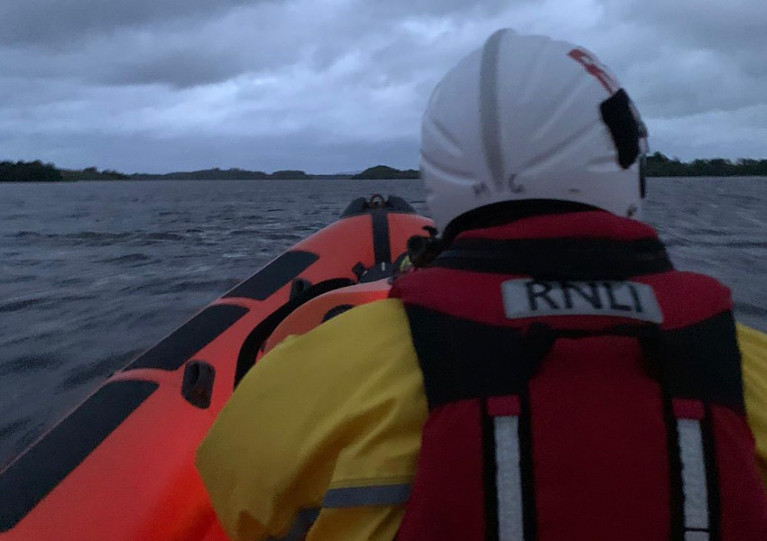Displaying items by tag: Enniskillen
Erne System: Temporary Closure of Enniskillen Jetties for Erne Classic Coarse Angling Event
Waterways Ireland advises masters of vessels and waterway users on the Erne System that the Castle and Henry St jetties in Enniskillen will be closed for three periods in the upcoming week to facilitate the Erne Classic coarse angling competition in the Co Fermanagh town.
Mooring will not be permitted at these jetties on Monday 9 May between 7am and 7pm, Wednesday 11 May between 7am and 7pm, and Friday 13 May between 7am and 5pm.
The RNLI in Carrybridge and Enniskillen on Lough Erne received a donation of £1500 from Wild Blue Green Yonder following a charity swim around Castle Island in Enniskillen.
The swim was held in September as part of the Festival Lough Erne events and had approximately 30 people in attendance to take part in the 750 metre swim around the island. The group had previously attended an open water swimming course organised by the Policing and Community Safety Partnership (PCSP).
The cheque was presented to Peter Scott from the Lough Erne Fundraising Branch for the Carrybridge and Enniskillen RNLI stations. Peter is also Water Safety Officer for both stations and part of that role is to provide education training around water safety.
Stephen Scott, Lifeboat Operations Manager, at Carrybridge RNLI praised all those who took part in the swim for all their hard work and dedication raising money for both lifeboat stations on Lough Erne. “The funds raised are vital to the continuing work of the RNLI on Lough Erne, both at our Carrybridge and Enniskillen stations, and will assist with future life saving operations. We are delighted to have strong links to the community here in Fermanagh and would wish to record our thanks to Wild Blue Yonder for the donation we have received.”
Carrybridge and Enniskillen Lifeboats Receive Generous Donation
The volunteer lifeboat crews of Carrybridge and Enniskillen RNLI were recently delighted to receive a donation of £1,600 raised at a special event that crossed swimming with mindfulness.
‘Wild and Free at the Sea’ was held by Dips N Hips in Rossnowlagh, Co Donegal last September, welcoming 50 people for a day of open water swimming, yoga and mindfulness on the beach.
It also marked the beginning of a ‘dip a day’ challenge for the month of October, where organiser Coná Gallagher braved the waters of Lough Erne every single day.
On behalf of Dips N Hips, Coná handed over a cheque to Ivan Kee from the Lough Erne Fundraising Branch for the Carrybridge and Enniskillen RNLI stations.
Stephen Scott, lifeboat operations manager at Carrybridge RNLI, praised all those who took part in the challenge and in particular Coná for all their hard work and dedication raising money for both lifeboat stations on Lough Erne.
“The funds raised will have a significant impact for the crews at both Carrybridge and Enniskillen and will assist with future lifesaving operations,” he said.
A father and son from Bellanaleck are among eight new lifeboat crew members who will carry pagers for the first time this Christmas at Carrybridge and Enniskillen RNLI in Northern Ireland.
As the RNLI continues its Christmas Appeal, Brian and John Sammon — who are ready to swap turkey and pudding for the December waters of Lough Erne — are urging people across Co Fermanagh to help their fellow crew, and the thousands of other volunteer crews carrying pagers over the festivities, to continue their lifesaving work.
It was when 19-year-old John became eligible to become a crew member two years ago that the family duo encouraged each other to join.
Brian says: “I had thought about joining the lifeboat crew at different times over the years because I was so aware of the work of the RNLI and I really wanted to give something back, but it wasn’t until John reached the eligible age at 17 and we saw a recruitment drive for new crew that we encouraged each other to get involved. We attended an open night and it just snowballed from there.”
Having received their pagers in November, Brian and John are now preparing to hear the beeping sound as the request for help comes in for the first time.
“We are excited but also nervous at the same time,” Brian says, “but we are here, and we want to help. That is why we joined; we want to support what is an invaluable service on Lough Erne.”
Among the other new crew members at Carrybridge are Simon Kidney, Matthew Nelson, Simon Carson, Paul McDaid and Cliff Walters, while Richard McFarland has joined the lifeboat crew at Enniskillen.
Richard, who lives in Lisbellaw, has always had a great love for the water but having worked away he couldn’t commit to joining the lifeboat crew until he returned home.
“This is my first Christmas on call,” Richard says, “and I know even over the festive period, our lifesavers are ready to drop everything at a moment’s notice and rush to the aid of someone in trouble on the water…We hope that this year’s Christmas appeal will show people just how tough it can be, but also that with their help we can get so much closer to our goal of saving every one.”
To make a donation to the RNLI’s Christmas Appeal, visit RNLI.org/Xmas
In a busy Tuesday afternoon (27 July) for Enniskillen RNLI, the volunteer lifeboat crew launched on two callouts in the vicinity of Castle Archdale.
The first came at 4.30pm after a passer-by alerted the coastguard to a person who went overboard from their vessel.
In choppy conditions with a strong westerly Force 4-5 wind, the inshore lifeboat John and Jean Lewis as well as the rescue watercraft sped to the scene.
On arrival, they found that the casualty has managed to get back on to their Whaley boat when it came to a halt and returned to shore to seek assistance.
Crews from the Northern Ireland Fire and Rescue Service and NI Ambulance Service took care of the casualty on shore as they had spent some time in the water.
On returning to the station, the volunteer crew spotted a cruiser with two adults and a dog on board that was struggling in the challenging weather.
After transferring a crew member onto the vessel, the lifeboat volunteers were able to take command of the cruiser and safely navigate it back to the jetty at Rossigh. All on board were in good health but were a little shaken by the conditions.
Speaking following the callout, Enniskillen RNLI helm Stephen Ingram said: “It is very easy for things to go wrong in rough weather. We would remind people to use safety equipment and make sure to the ‘kill cord’ is properly attached. Always bring a means of communication with you and make sure to check the weather forecast before heading out.
“We would also like to commend the individual on the shore who called the coastguard. When you spot something happening on the water the best thing to do is dial 999 and ask for the coastguard.”
Enniskillen RNLI launched to the aid of four people on a speedboat adrift in shallow water in the vicinity of Castle Archdale yesterday (Sunday 13 June).
Following a request from Belfast Coastguard, the volunteer crew launched the station’s inshore lifeboat John and Jean Lewis at 7.35pm to go to the aid of the 16ft speed boat, which had engine difficulties and was adrift in the Castle Archdale area of Lower Lough Erne.
Weather conditions at the time were choppy with a south-westerly wind.
The crew quickly found the drifting boat on the western side of Crevinishaghy Island.
All four adults onboard were found to be safe and well and wearing the correct safety equipment.
The volunteer crew then established a tow between the lifeboat and the vessel and all casualties were brought to Castle Archdale marina safely.
Waterways Ireland Seeks Expressions of Interest to Operate Water Activity Business at Enniskillen
Waterways Ireland invites expressions of interest to operate a watersport activity business at the Enniskillen Blueway Water Activity Zone in the Co Fermanagh town.
Forms and information packs are available from [email protected] and the closing date for submissions is Friday 26 February at 2pm GMT.
Erne System: Portora Lock Closure for Maintenance This Week
Waterways Ireland advises that Portora Lock on the Erne System near Enniskillen will be closed to boat traffic on Tuesday 19 and Wednesday 20 January to accommodate essential maintenance works to the lock gates.
Masters of vessels on this inland waterway are asked to heed all instructions from safety personnel who will be in the area.
Six Rescued From Lough Erne Boats Jostled In Strong Winds As Fermanagh Braves Worst Of Storm Ellen
Six people were rescued from their boats on Lough Erne as Storm Ellen swept over Northern Ireland in the early hours of Thursday (20 August).
Enniskillen RNLI said the vessels, which were moored at the Devenish West jetty, were breaking their moorings in the strong winds.
All six passengers across the two brought to safety in Enniskillen aboard the inshore lifeboat.
Meanwhile, three other vessels breaking their moorings at Lough Erne Yacht Club were assisted by the lifeboat station’s shore crew.
Fermanagh braved the worst of Storm Ellen in Northern Ireland, while the Foyle Bridge in Derry had to be closed for a time amid gales and driving rain, as the News Letter reports.
Enniskillen and Kenmare on Song at Castleconnell Head
#Rowing: Enniskillen, Kenmare and the host club all had notable results at the giant Castleconnell Head of the River today. Enniskillen’s girls’ eights were fastest at junior 18, junior 16 and junior 15 level – and their junior 18 women’s quadruple also hit the mark. The top junior 18 single sculler was Eabha Benson of St Michael’s. Georgia O’Brien was the top senior single sculler.
O’Brien is a Kenmare woman, and her club of origin had two remarkable results. Tom Kelly won the junior 18 singles and teamed up with 16-year-old Rowan Glynn-Johnston in the junior 18 double sculls to record a brilliant time of 11 minutes 12 seconds. Kealan Mannix of the University of Limerick was the fastest senior with a time of 11 minutes 52 seconds.
Enniskillen’s junior men’s eight were the fastest of all, in nine minutes 58 seconds, while UCD B were the fastest four with a time of 10 minutes 21 seconds.






























































